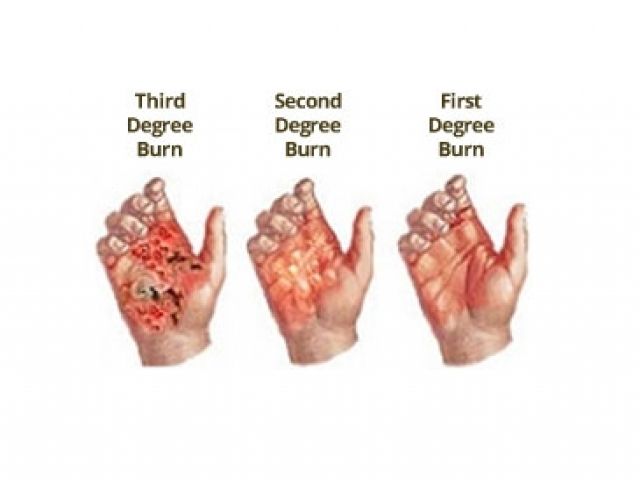1st vs 2nd degree burn
Currently the determination of burn depth based on clinical examination is only 70 accurate 1. A third degree burn is the worst among them.
 |
| First Second And Third Degree Burns Degree Burns Burns Burns Treatment |
First degree burns show characteristic like redness and some mild swelling of the skin.

. The types of burns are. It can be difficult to effectively stratify burn wounds. Second degree burns are severe than the first degree burns. Affects only the epidermis the outer layer of the skin causing redness and pain.
Your dermis is the area right under the topmost layer of your skin and eventually it will come to the surface and become the epidermis. These burns only affect the outer layer of your skin. A burn is a dynamic process for the first few days and a burn that appears shallow on day 1 may appear deep by day 3 2. The burn site is red painful dry and with no blisters.
It may be a simple matter to differentiate between first and second degree burns but it is often more difficult to differentiate between superficial and deep partial-thickness burns. The outer and underlying layers of skin are affected by second- degree burns. They cause pain and reddening of the epidermis outer layer of the skin. A deeper burn may require more fluid resuscitation.
Mild sunburn is an example. Deep second degree burns sometimes require grafting and a surgeon should be consulted if there is any doubt particularly when burns are extensive. The first aid management is common to all burn injuries and management with analgesics when there is pain. Long-term tissue damage is rare and usually consists of an increase or decrease in the skin color.
2Second-degree burns affect the epidermis and the dermis layers of the skin which are characterized by blistering. 1First-degree burns are the mildest most superficial type of burn that heal the fastest. Second-degree burns usually heal within two to three weeks. Needless to say minor sunburn can be categorized as a first degree burn.
Second-degree burns cause noticeable damage to the skin. These burns cause no or little pain due to the damage caused in the nerves. Common First-Degree Burn Characteristics. A person with first degree sunburn may notice the following skin symptoms usually about 4 hours after exposure to sunlight.
They can cause pain redness and swelling. Does not cause a break in skin Reddening of skin Sensitive to touch and possibly itchy Flaky skin that may peel or slightly swell Pain dissipates quickly Second-Degree Burns Also Impact The Dermis These burns impact both the epidermis and the second layer of skin and thickest called the dermis. First-degree Superficial burns burns are considered mild compared to other burns. The higher the degree the more severe the burn is.
First-degree burns usually heal within seven to ten days and leave no post-burn scars. The first degree burns do not require any surgery as it heals with no scarring by 1 weeks duration. A warm or tight feeling. What does a second degree burn look and feel like.
Blisters form as a result of damage to the second layer of the skin. Second-degree - partial thickness burns. Redness which is more apparent on light skin. You can have a first- second- third- or fourth-degree burn.
They exhibit the characteristics like skin with swelling and blister formation. There are three types of burns. Answer 1 of 2. What is a Second Degree Burn.
First-degree burns superficial burns are mild compared to other burns. This is a more serious burn and is typically a progression of 1 st degree. First-degree burns affect only the epidermis or outer layer of skin. When that happens the two layers of skin start to separate leading to formation of blisters.
A second degree burn affects not only the epidermis but also the dermis. 3They usually need at least one month to completely heal. Affects the epidermis and dermis inner layer of the two main layers of skin and includes signs of redness swelling blisters and blotches. The second degree burns form scarring unless properly removed and the third degree requires a skin graft.
The outer layer of the skin is affected by first- degree burns. They are notable for having blisters. But medically speaking it would be better if we classified based in the thickness of skin involved. This is one way of classification.
Second Degree Sunburn 2nd Degree Sunburns. They are also known as partial-thickness burns as they partially affect the inner layer of the skin as well which is known as the dermis. They cause a lot of pain.
 |
| What Do I Do For A Burn Homeopathic Remedies Homeopathic Treat Burns |
 |
| Coconut Oil For Burns Real Me Monday Coconut Oil For Burns Essential Oil For Burns Home Remedies For Burns |
 |
| Ny Burn Injury Lawyer Explains How Burn Injuries Can Come In Many Forms Frekhtman Associates Burns Nursing Wound Care Burn Injury |
 |
| First Aid For Burns 1st 2nd And 3rd Degree In 2022 2nd Degree Burns Treatment Superficial Burn Burns Treatment |
 |
| 2nd Degree Burns Degree Burns Nursing Study |


Post a Comment for "1st vs 2nd degree burn"